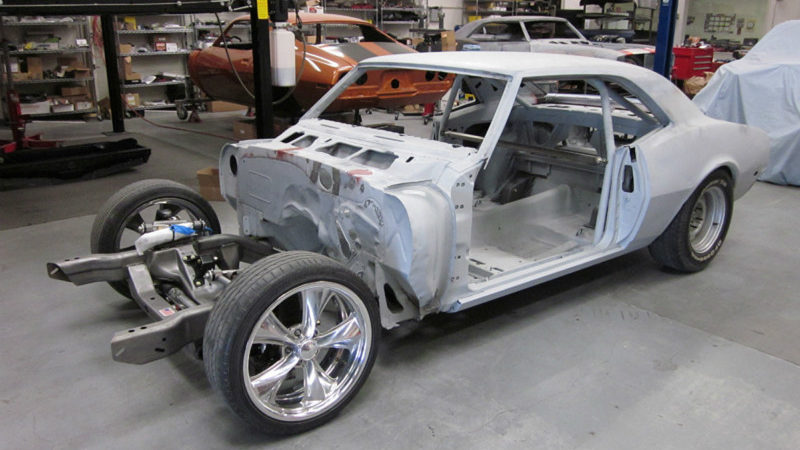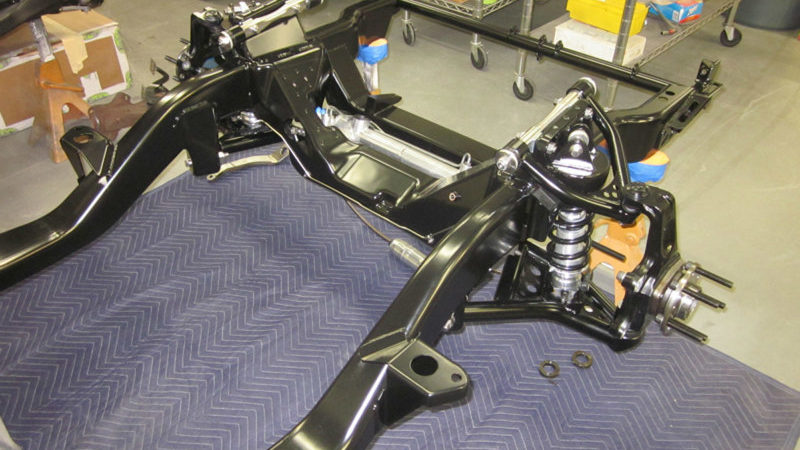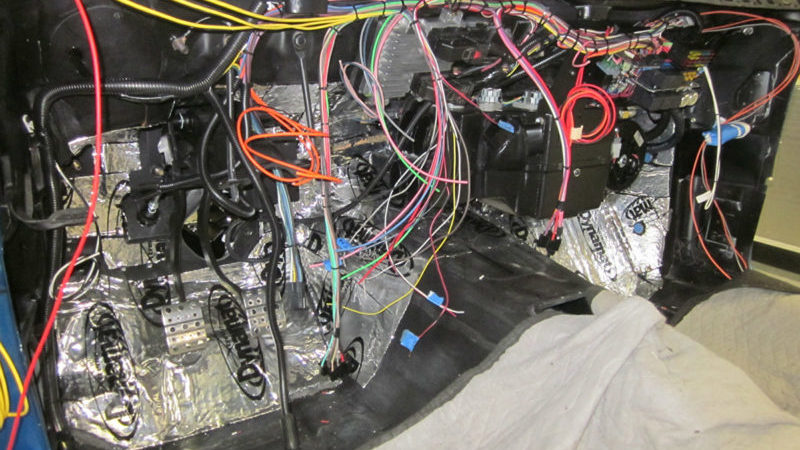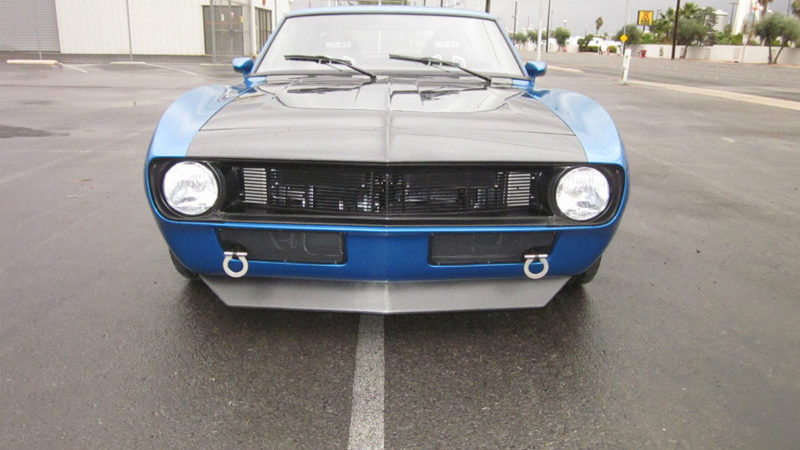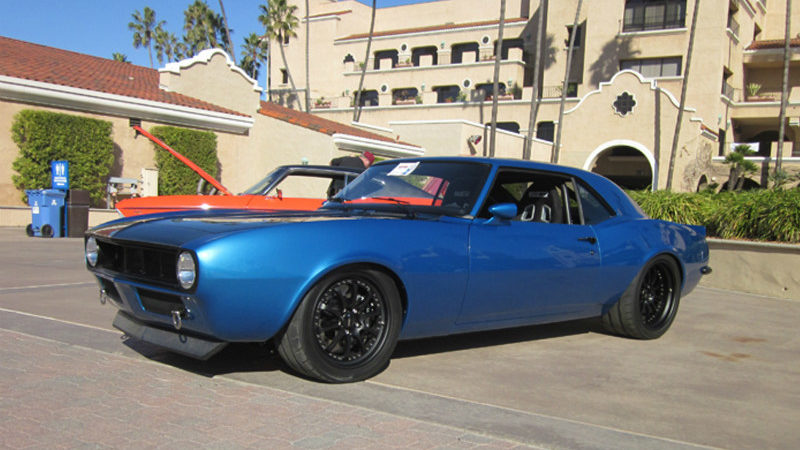1968 Camaro – Blu Balz
FollowVehicle Quick Facts
Profile ID: 13662
Year: 1968
Make: Chevrolet
Model: Camaro
Markets: Muscle Car
Vehicle Type: American
Contact: JCG Restoration & Customs
![]()
Vehicle Story
If any one build put JCG Restoration & Customs on the map, we’d have to say it was Blu Balz. Sure the name begs attention but there’s a lot more to this ’68 Camaro than a catchy name.
Blu Balz belongs to Karl Dunn, a Tennessean who has experienced a plethora of cars and activities, the most salient being a yen for autocrossing. But that was then. So years fly by and our protagonist realizes that the bug has not left him (will never leave him) and once again demonstrates interest—this time in the Pro Touring regimen. It’s got all the facets of the original concept but includes street rubber that is better than the race tires of the period and in diameters ranging from 18 to 20 inches instead of 15-inch standard of old.
Karl had been reading about events like the Motorstate Challenge and the Run to events on pro-touring.com and lateral-g.net. To him, the competition sounded like a great way to run his cars without risking jail. In 2010, he did his first event, the Midwest Muscle Car Challenge, in an ’07 Mustang. That was all it took to sink the hook. Last year he did RTMC, Motorstate 3, Heidts, MMCC2, Peach state, and RTTH 7. He hadn’t had so much fun since the old MX days.
The cars that influenced him the most were our own Steve Rupp’s Bad Penny and Mark Stielow’s Camaro X. He likes Bad Penny because Steve is continually pushing the envelope on what you can do to a Camaro, and because Penny looks so bad ass. Accordingly, Camaro X demonstrated simplicity and integration of components, like the DSE suspension, the LS7 engine, and simply because Mark’s cars appear to have been built in a factory.
When Karl saw pictures of Cris Gonzalez’s, owner of JCG Restoration & Customs, own fat-bottom ’69 he immediately tumbled for it, his proclivity for fat fenders producing copious drool and profound longing. He told Cris he wanted a piece that was capable of running with the cars that were dominant, specifically the Camaros of Kyle Tucker, Brian Finch, and Steven Rupp. He knew he didn’t have their driving skills, but he wanted a car that was competitive with theirs. His plan with the widening was to emulate Bad Penny, but have a more expansive track and be able to run fatter tires. And when he devoured Ben Hermance’s rendering, he knew he was on the right track.
Aside from the elegant, understated construction and the one-off billet pieces from JCG, there are other key players here. Ken Whitney from Wire One did all the electrical work; Eric Thorsen at Eric Thorsen Custom Interiors sussed out the closet space; and the mighty Pozzi duo, Dave and Mary, for their considerable insight and hands-on suspension/chassis remediation.
Karl stifled the tendency for mega-power and gave the Camaro a nice blend of balls and grunt with a modified LS7 conversion, including the 11-quart OE dry-sump oiling system and a ZL1 oil pump. QMP Racing Engines in Chatsworth, California, glommed an ’07 427. On top of the requisite balance and blueprint, QMP replaced the factory fasteners with ARP hardware, the cast pistons with Mahle 11.0:1 forgings, and the pushrods, lifters and camshaft with COMP equipment. Estimated output is 600 hp at 6,800 rpm and 550 lb-ft of torque at 4,700 rpm—a powerful and very drivable combination. Ancillaries include 17/8-inch primary-pipe DSE stainless headers feeding a 3-inch JCG stainless system, an X-pipe crossover and Dynomax silencers. For cooling, JCG instituted a two-row Auto Rad aluminum core and mounted a Setrab oil cooler at the front of the vehicle. A JCG accessory drive ties the A/C compressor, alternator, and steering pump together, and in the slick-bits department, we see carbon-fiber rocker covers and the following JCG equipment: coil pack relocators, air-cleaner housing holding K&N element, a vented power steering tank, and a coolant catch can.
Getting grunt to the wheels begins with the OE flywheel and an ACT pressure plate and disc whirling inside a Quick Time bellhousing. The six-gear Tremec twists a Coast Driveline aluminum propeller shaft at the Moser 9-inch with 3.89 gears gnashing on the Detroit TrueTrac differential.
For the chassis/suspension combination, Cris collected all that DSE offers. He installed the hydroformed subframe and all that comes with it (control arms, steering rack, anti-sway bar, etc.). AFCO coilover adjustable dampers control wheel movement and establish a 3-inch drop in ride height. At the other end, a QUADRALink four-bar system locates the axle, includes an anti-sway bar and is damped by AFCO coilovers that lower the body 4 inches. DSE subframe connectors bring both ends of the car together as well as giving the car increased resistance to torsional and lateral bending. JCG fortified the car further with a DSE abbreviated cage and took opportunity to accommodate the out-sized tires by inserting DSE’s king-size king wheel tubs.
The energy burners are requisite Wilwood, 6- and 4-piston assemblies servicing 14- and 13-inch hats that are all but submerged beneath the blacked-out ZX3R Forgeline wheels. The stretched fenders easily swallow the 18 x 10 hoops and the 295/35 Nitto NT05 skins in front and the 19 x 12 wheels and 335/30 NT05s on the business end.
Moving into the comfort zone, we find black subdue, the work of Eric Thorsen who works out of nearby Agoura Hills, California. Thorsen leathered-up the door and side panels and finished off the storage compartment and the access lids where the rear seat once squatted. Aside from air conditioning, the only other blatant creature comfort is the Kenwood head (with DVD player), the Focal 5½-inch front and 6 x 9 rear speakers. Sparco seats stand tall, accompanied by four-point Sparco belts. JCG built a custom dash panel with a second-gen Trans Am flavor to it, and the billet dash insert holds a complement of ProParts Spek gauges. JCG finished the tableau with a custom billet center console. The big round thing on the adjustable steering column is a Sparco item; the shifter is part of the Tremec conversion.
Overall views of the Camaro aptly illustrate the benefits of being fat. Cris’s superbly hogged-out wheelwells are perfectly aligned and arched and lend immediacy and vibrancy to the overall silhouette. Aside from the considerable work to build the fat fenders, JCG smoothed out the sheet metal, removed the front bumper and got down with the D-rings, the carbon-fiber spoiler, understated JCG grille, and the featherweight Anvil carbon-fiber hood. They also erased the side marker lights, flushed-mounted the taillights, integrated one of their rolled pans and worked the rear bumper accordingly. Pacific Coast Powder Coating in Palmdale, California, surely did its best to produce contrast where it was needed. Finally, they finished the exterior off with PPG Corvette Jet Stream Blue. And any male knows what the name implies and how one arrives at that often-painful state. Steven Rupp put the two together—the frustration from waiting with the blue Camaro—and the name was born.
Build Sheet
Manufacturers
- American Autowire - Wiring
- Detroit Speed, Inc. - Front & Rear Suspension: hydroformed subframe, abbreviated cage, wheel tubs
- Forgeline Motorsports - Wheels: blacked-out ZX3R's 18 x 10 front, 19 x 12 rear
- JCG Restoration & Customs - Complete build, Sheet metal fab, Body & Paint
- JRI Shocks - Shocks
- Mac’s Tie Downs - Tie-downs
- Maxima Racing Oils - Fluids
- TREMEC - T-56 Transmission
- Vintage Air - HVAC
- Wilwood Disc Brakes - 6- and 4-piston assemblies servicing 14- and 13-inch hats
- XSPower Batteries - Battery
Shops
- Ultimate Performance - Shock tuning







